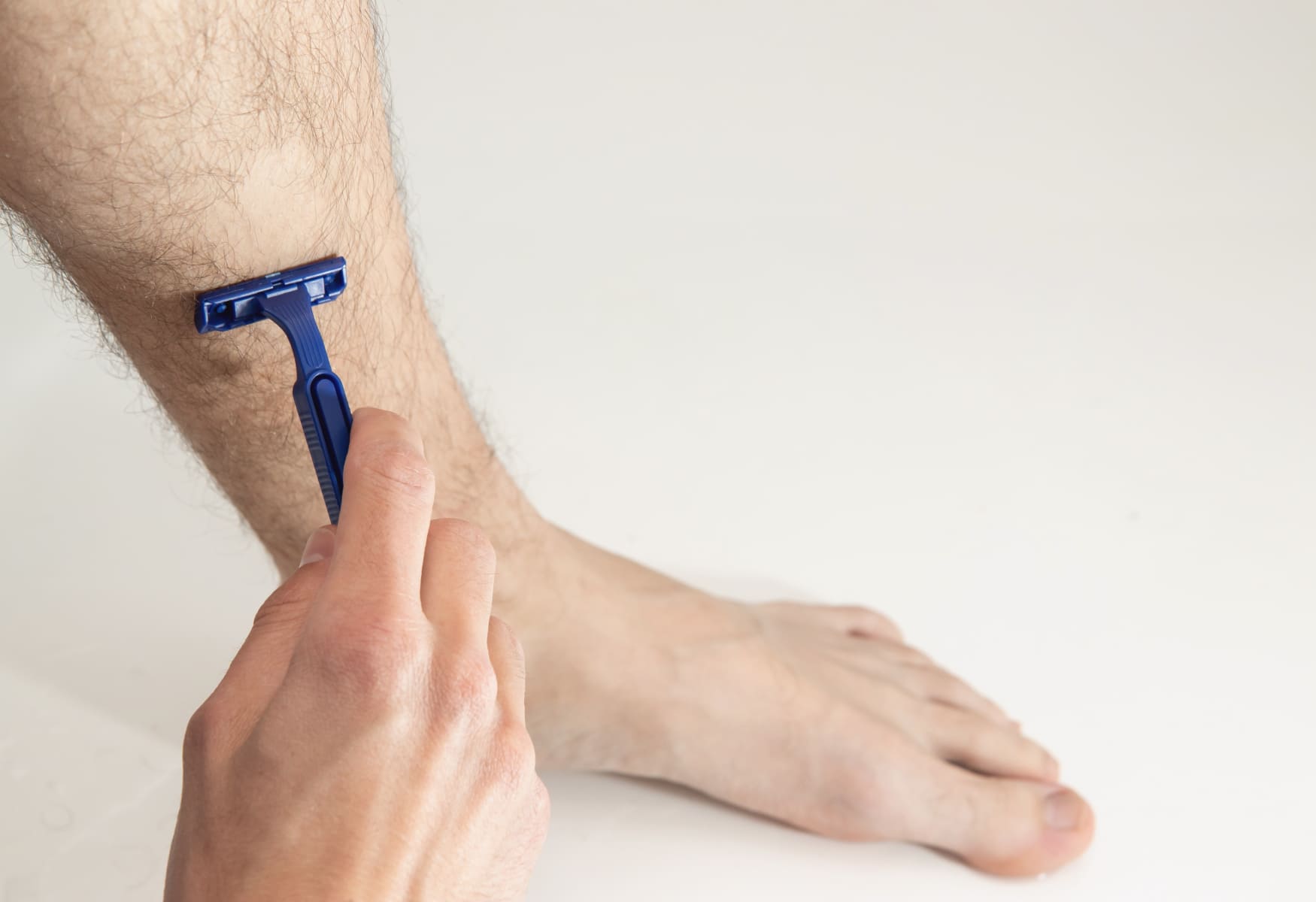Perfectly smooth legs have almost become an aesthetic norm for women. At the same time, the number of men who, for various reasons, don’t want hairy legs is also growing. Where do leg hairs even come from? How has the perception of them changed over time? And what options are available for those who want to get rid of them? You’ll find the answers to all of this in our article.
Obsah
Our salon does not decide on matters of fashion and taste. We respect the choice of all those who want to keep the hair on their legs, and we also open our doors to everyone who wants to get rid of it! Get a discount on your first laser hair removal treatment with us, which will permanently solve your hair problem.
Hairy legs and the trend for perfectly smooth skin
As we have already said, the aesthetic trends are clear, at least for women – perfectly smooth skin on the feet above all. Hairy legs can raise eyebrows in society and many men simply find them unattractive. Women with hairy legs also expose themselves to the suspicion that they are not taking care of themselves.
This is, of course, a culturally conditioned view of sexy legs that people in other countries and at other times have not always shared. So we dare not say whether this is right or wrong.
But the fact remains that constant shaving, waxing and other hair-fighting methods are now a normal part of most women’s routine. Even many a man today opts for bare legs for aesthetic, practical or health reasons.
But there is a flip side to the trend for perfectly smooth legs.
- Maintaining smooth legs requires regular care, and it comes with a time and sometimes financial commitment.
- Depending on the method you use, continuous hair removal can cause a number of discomforts. These can include skin irritation, ingrown hairs, and in extreme cases, infections and the formation of permanent scars.
- Some hair removal methods can be quite painful. Yes, we are primarily referring to the notoriously infamous wax depilation or mechanical epilation, where the hairs are pulled out.
- There is also a psychological side to the problem. Social pressures to achieve a "perfect" appearance sometimes lead to anxiety and low self-esteem. Young people in particular are often bombarded with unrealistic beauty standards and this takes a toll on their mental health.
No wonder many people are turning away from the trend of perfectly smooth legs. Either because of a return to “naturalness” or simply as a rebellion against the established norms. After all, why not?

Excessively hairy legs in women and what causes it?
Every woman has some hair on her legs from time to time. It’s nothing special or unnatural, and such hairs can easily be removed using one of the many shaving, epilating, or depilating methods.
However, excessively hairy legs pose a significant complication for many women. But what is the reason that one hair after another sprouts on their legs compared to other women?
Women's hairy legs can be caused by genetics
Sometimes a woman simply inherits hairy legs along with the rest of her genetic makeup.
The amount and density of body hair, including leg hair, are largely hereditary. It runs in families and sometimes even in entire nations and ethnic groups. You may have also come across jokes about Portuguese women being hairier than their male counterparts…
Even without exaggeration, it remains a fact that in many cases, thick body hair is simply a matter of genetics.
Hormonal imbalance
Another significant factor in the density of body hair is hormonal imbalance. Changes in hormone levels, especially increased production of androgens (male sex hormones), can lead to hair growth in areas typical of men, including the legs.
Hormonal imbalances usually have natural causes related to normal development at puberty or menopause. But sometimes it is also caused by various diseases.

Polycystic Ovary Syndrome (PCOS)
Polycystic Ovary Syndrome (PCOS) is one of the most common health conditions associated with hormonal imbalance, which, among other things, causes excessive hair growth (hirsutism).
PCOS is a condition where women produce higher levels of androgens, leading to hair growth on the legs, face, and other parts of the body.
Women's hairy legs can also be caused by taking certain medications
In some cases, excessive hair growth may also be related to the use of certain medications.
We’re talking specifically about drugs that affect hormonal balance, such as certain steroids, anticonvulsants, and medications for high blood pressure. Their use is sometimes accompanied by unwanted bodily changes, including the growth of body hair.
As we can see, the range of causes for excessive leg hair growth is quite broad. Besides hair removal, whether done at home or through permanent laser hair removal at a professional salon, we also recommend seeking a consultation with a qualified dermatologist or endocrinologist.
Hairy legs in men. When is it worth getting rid of them?
Men are naturally hairier than women, and unlike women’s body hair, men’s body hair isn’t accompanied by significant stigmas.
However, men don’t have to feel embarrassed if they dislike the hair on their legs and want to get rid of it. Not everyone finds hairy legs aesthetically pleasing – and that includes some women. This is especially true when it comes to excessive hair that’s hard to ignore.
The idea that body hair is a symbol of masculinity has long been outdated.
Men might also consider male hair removal in the following situations:
Sport and athletics
Many professional athletes, including cyclists, swimmers, and runners, remove hair from their legs to reduce friction and thus improve aerodynamics or hydrodynamics. Smooth skin also makes it easier to apply sports bandages or massage creams.
Medical procedures
Removing leg hair is sometimes necessary before certain medical procedures or surgeries to reduce the risk of infection. Hair is also commonly removed in preparation for treatment of skin conditions.
Aesthetic and personal preferences
Some men opt for leg hair removal for aesthetic reasons or because of personal preference. It may be a desire to have smoother skin, more sculpted muscles, or simply to suit a partner's personal taste or preference.
Prevention of ingrown hairs
In some cases, removing leg hair is the best way to prevent ingrown hairs.
Tattoos
Men who want to get a tattoo on their leg may sometimes need to remove the hair in the area where the tattoo will be applied for a cleaner and more precise result.
In short, it's convenient
Removing leg hair occasionally will also increase your comfort. Especially in hot weather or in cases where thick hair causes irritation and itching.

Hypertrichosis
Some men suffer from so-called hypertrichosis, i.e. hair growth that already exceeds the normal level of natural pubic hair.
Hypertrichosis may be partly genetic, but it may also have other causes. The most common are adrenal gland disease and the overproduction of sex hormones caused by it.
And, as in women, hypertrichosis in men can be triggered by the use of certain medications or hormonal fluctuations.
In case of hypertrichosis, we also recommend seeking the help of a specialist doctor. Conventional hair removal methods may not produce the desired results until the cause of the problem is addressed.
Common methods for hairy legs
Shaving of leg hair
Základní a nejrychlejší metoda odstraňování chloupků. Its disadvantages include an increased risk of ingrown hairs and the need for frequent repetition to maintain smooth skin - virtually daily shaving is necessary for best results.
On the other hand, shaving is rightfully the most widely used method of combating hair because of its low cost and ease of use. The important thing is to use sharp and good quality razors or shavers. Disposable razors are not as effective and can be harsher on the skin.
Depilatory creams
Simple to use - apply, leave on, wipe off and the treatment is complete. Depilatory creams dissolve keratin, which is the main building material of hair. However, they are quite irritating for some skin types, especially the more sensitive ones. So people with sensitive skin should consider alternative methods instead.
Waxing or sugar paste waxing
Application of warm wax or wax tape, its hardening and then sharply pulling it off against the direction of hair growth.
This method allows hair removal for up to four weeks. However, the main drawback is the high painfulness of the whole procedure. You can get used to it, but you will probably never have a pleasant hair removal.
For optimal results, it is advisable to visit beauty salons, which can be both financially and time-consuming.
Sugar paste waxing works similarly to waxing, but is a little gentler and less painful and may be a better alternative for sensitive skin.
IPL hair removal
Intense Pulsed Light (IPL) is a modern technology used for long-term hair removal.
IPL uses a broad spectrum of light to hit multiple hairs at once. It can thus reduce hair growth after several repeated sessions and can be used on different parts of the body, including the legs.
IPL is less painful compared to waxing and can be gentler on the skin than traditional hair removal methods.
However, the main disadvantage of IPL is the low effectiveness of the treatment compared to laser hair removal. The intensity and precision of IPL simply cannot match professional alexandrite or diode lasers - just check out the laser hair removal reviews.
Thus, IPL hair removal may not be effective for all hair and skin types, especially for very light hair or darker skin where there is a higher risk of irritation or skin damage.
Laser hair removal is the only method that permanently destroys hair on the legs
Do you want to have really smooth feet at all times? Then there is only one way to achieve this, and that is laser hair removal.
This technique is unique in its ability to achieve lasting results. The laser generates heat when it comes into contact with the pigment in the hair. The heat energy penetrates the hair follicle, effectively destroying it so that it does not grow back – at least for a few years.
One session of laser hair removal for both legs takes approximately 45 minutes. When epilating only a selected area, such as the calves, it is even less. For complete hair removal, typically 5-6 sessions are required, spaced several weeks apart.
So the whole process may take several months, but the result is worth it: several years without any further hair worries.
Moreover, laser hair removal is very gentle compared to other hair removal methods. Thanks to modern lasers with integrated cooling systems, the treatment is completely comfortable and pain-free.
For those with more sensitive skin, a soothing cream can be applied, further minimising any discomfort.
In addition, laser hair removal is suitable for all shades of hair and skin, and because of its gentleness, it is also recommended for treatment of people with sensitive skin, in any body part. It is also suitable for epilation of the groin or bikini area.






